The second round of the 2020/2021 WSL season gave us some really interesting match-ups, with one of those being Everton Women against Tottenham Hotspur Women. The game as a whole wasn’t the greatest, with it only being decided by one goal, and not many clear cut chances were created, but there were still some points worth mentioning. In this tactical analysis, we will look at the tactics both sides used in their attacks, looking for the differences that led to Everton winning and Tottenham losing the game. The analysis will also look at the role Izzy Christiansen had in the win, aside from scoring the winning goal.
Lineups

Everton Women made two changes from their opening round win at Bristol City Women last weekend, with midfielder Maeva Clemaron and forward Nicoline Sorensen dropping out. Starting in their places were Abbey-Leigh Stringer, who sat in front of the defence in Everton’s 4-1-4-1 formation, and winger Claire Emslie, who came on as a substitute against Bristol. Captain Lucy Graham was partnered by Izzy Christiansen in the midfield, playing behind lone striker Simone Magill, who also started for the second game running.
Tottenham Hotspur Women made four changes of their own from their opening draw at home to West Ham United Women. Centre-back Hannah Godfrey, left-back Siri Worm, forward Lucy Quinn and striker Rianna Dean all moved to the bench. Ashleigh Neville switched to left-back from right-back, with Ria Percival moving to right-back in her place. On-loan Canada centre-back Shelina Zadorsky partnered Kerys Harrop in the middle of the backline, whilst Alanna Kennedy, also on loan, joined Josie Green in the middle of the field. Rianna Dean was replaced by Rachel Williams, who joined Harrop in moving to the club from Birmingham City Women over the summer.
Tottenham Hotspur Women’s attack
With the match being decided by a single goal, it makes sense that we look in depth at both teams’ attacks, analysing why Everton won and Tottenham lost. We will first begin by looking at Tottenham Hotspur Women, looking at why they struggled to score in this game.

The first half saw Spurs create few chances, with the main reason for that shown in this image. Their chosen formation of 4-2-3-1 meant that Rachel Williams was often isolated at the top, with little support from those behind her. We know she prefers to play alongside another player, because that’s how Birmingham used her last year. This system didn’t seem to suit her as well.
Playing with one striker also meant that Everton found it easy to clear the ball. To do this, they split apart, making the pitch as big as possible, meaning they can shift the ball from one side to the other, creating space to clear the ball from. Goalkeeper Sandy MacIver is known for coming out of her box, and you can see in this image how she has formed a three-player defensive structure, with options either side of her.
All of this meant that Williams found it difficult to get a hold of the ball, resulting in Tottenham struggling in attack in the first half.
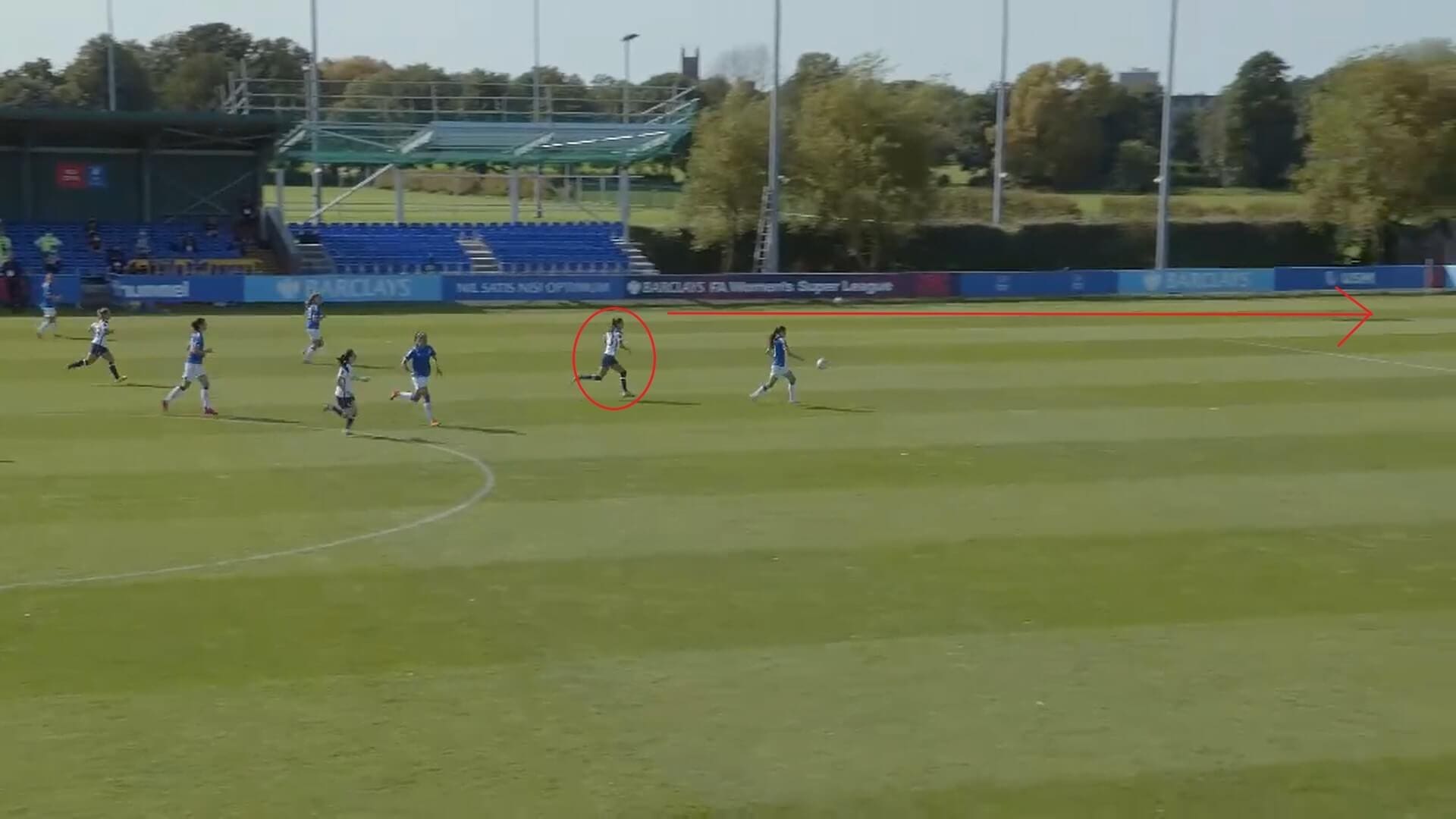
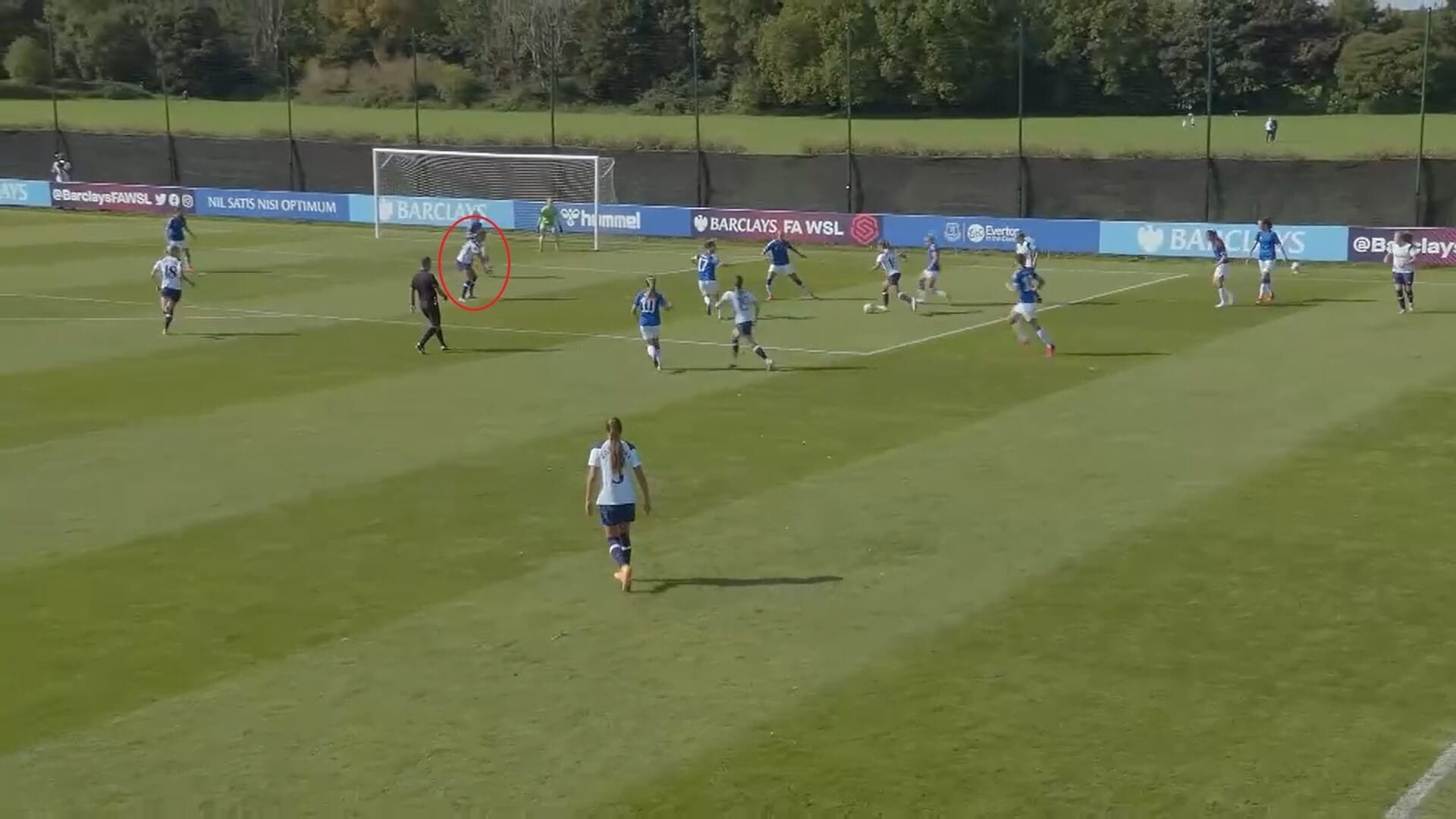
However, the main thing that needed fixing was that no Tottenham player seemed comfortable making a run forwards to put pressure on Everton’s defence. To solve this, they brought on Rosella Ayane for Williams at half-time, with the aim of applying more pressure, and you can see from these images how Ayane did just that.
The first image shows how Everton are playing the ball back to MacIver in the goal, but this time Ayane sprints towards it. Whilst unable to reach it, she does force MacIver into making an error with her clearance. This was the first mistake the goalkeeper had made with her clearances all game, proving how the introduction of Ayane gave Tottenham a new threat in Everton’s third.
The second image shows Ayane in the middle of the box, offering herself as a passing option. Again, she has added what Spurs were missing in the first half; a player who troubled the Everton defence. Tottenham didn’t create too many chances throughout the match, but they were more threatening in the second half, and this was one of the reasons for that.
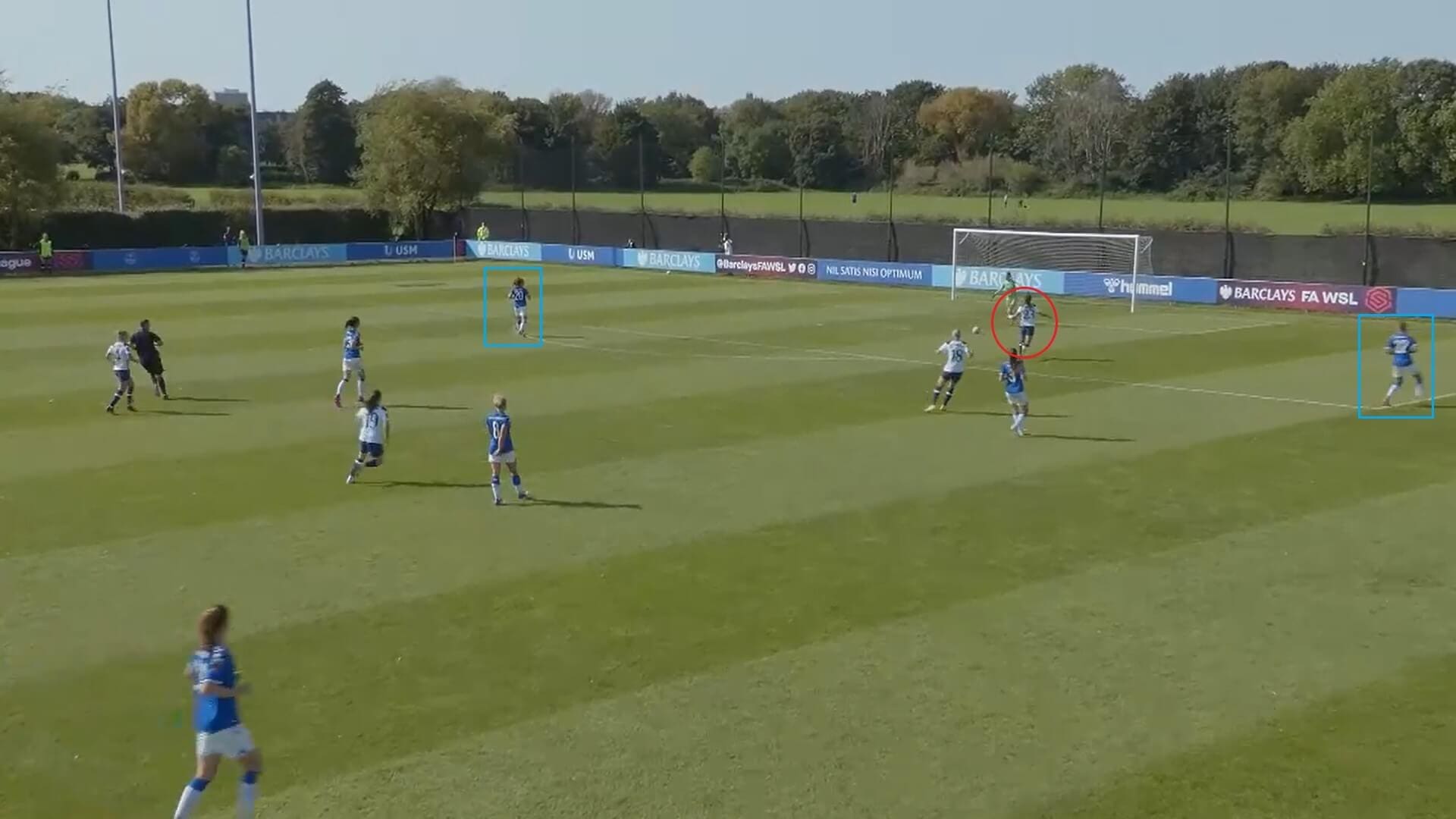
That is not to say that their formation changed in the second half, because it didn’t. If we look at this image, we can see only Ayane is in the forward area, with Everton’s defenders again on either side of her, making the pitch as big as possible. Therefore, whilst they were now putting pressure on the Everton defence, they didn’t get more players forward to support the lone striker. This image shows the result of that, and, because Everton controlled the width in their third, they always had a way of getting the ball out of danger in these situations.

This image shows another way that Tottenham’s attacks broke down early. We can see that Gemma Davison has the ball, in the middle of the pitch, with substitute Rianna Dean in the red circle nearest to us, and another Spurs player in the other red circle. This is a good structure to have in attack, because it isolates the defenders, who are close together (shown by the blue lines), and means that, if Tottenham can feed the ball through to any of these two players, then they have a route through to goal. However, Davison makes a straight pass, where Everton can intercept and clear it. If the ball had gone wider, it might have found its target, and errors were another reason that Spurs were never able to create many attacking chances in the match.
Everton Women’s attack
If we now look at Everton Women’s attack, we will see how they made tactical changes throughout the game that helped them to win.

Here, we can see the same setup that Tottenham Hotspur Women had in the second half. Spurs’ defenders have been caught between two Everton attackers, who are now looking to offer passing options to their teammate, as well as making the pitch as wide as possible. Therefore, we can see how both sides had this thought in their mind, but Everton were the ones who used it first, and were more successful in it.
This image also shows us how Everton worked together in their attacks, supporting each other, which is what Tottenham weren’t doing. This meant they carried more of a threat, as they covered more of the pitch when moving forwards. This was a regular feature of their attacks throughout the game.

Australia winger Hayley Raso, who is circled in this image, was Everton’s biggest threat in the first half, constantly coming off her wing and occupying good attacking positions. Here, she has positioned herself amongst the Tottenham defenders.
However, if we look at the wider picture here, we can see how Everton have players either side of the Spurs defence, which has narrowed as they try to stop Raso from getting through them. Therefore, again, when Everton attacked, they always had options available, even if they weren’t needed. Raso here got a shot away, which needed to be saved. What Everton missed in these situations was someone who could put the ball in the net, but positionally they were better set up than Tottenham were.
Another aspect of their attacking tactics was to press their opponents high up the pitch. If we look at the two images below, we can see how they did this.

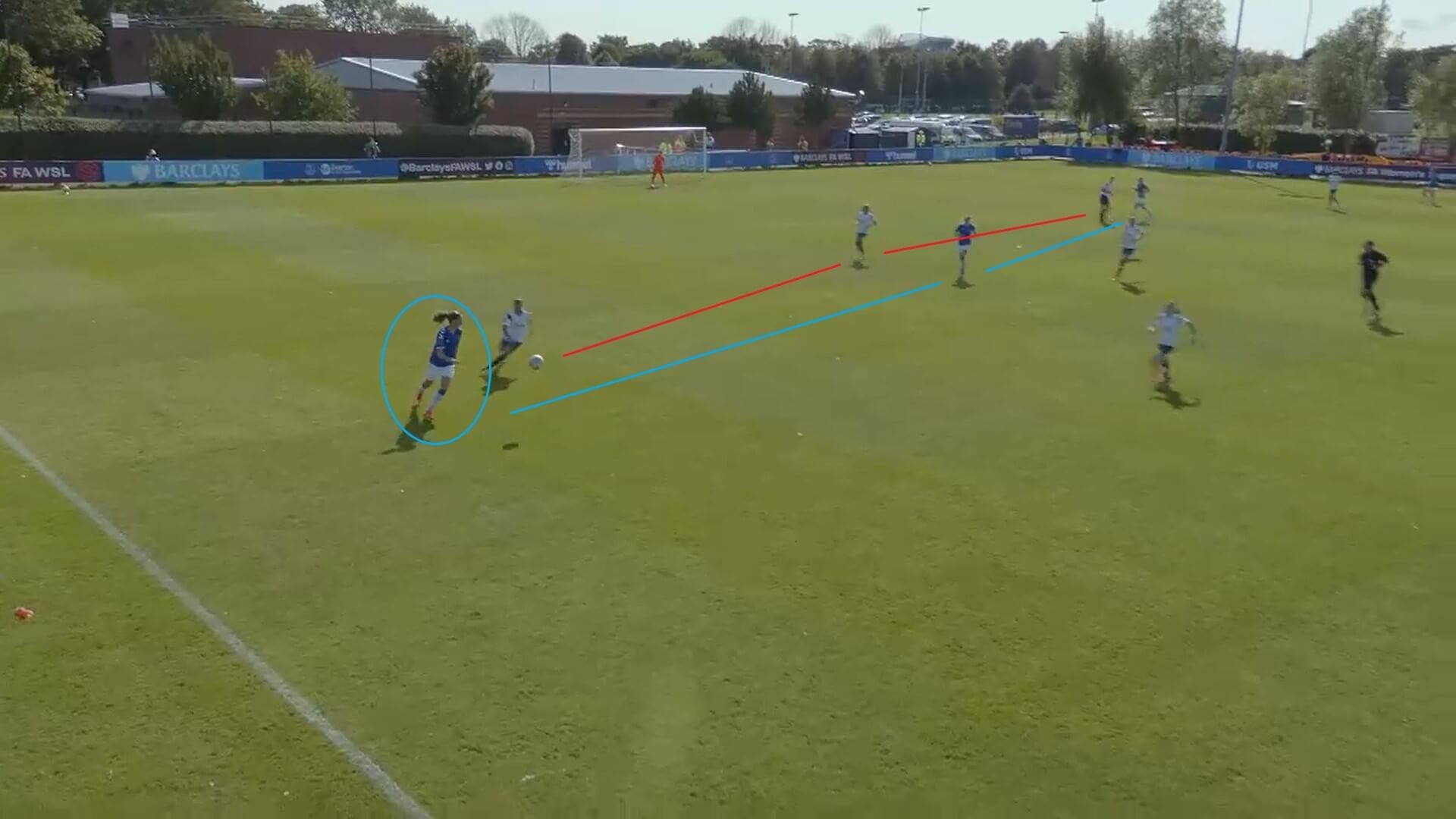
The first image comes from the first half. The three boxes show how every Tottenham defender was marked closely by an Everton attacker. If there was only one player attacking in these situations, then they would be in the same position that Spurs were, when Everton stretched the play across the pitch to get the ball around them. However, because they pressed as a team, they gave Tottenham no space to move around, constantly forcing them to move backwards.
The second image shows how this continued in the second half. Again, Everton have split across the pitch, matching Tottenham’s formation. In the circled box is Nicoline Sorensen, the Denmark international signed from Brondby this summer, who came on and made a difference to their attack in the second half. This is something we will look at later on.
A third image of Everton’s team press is shown in the image below.
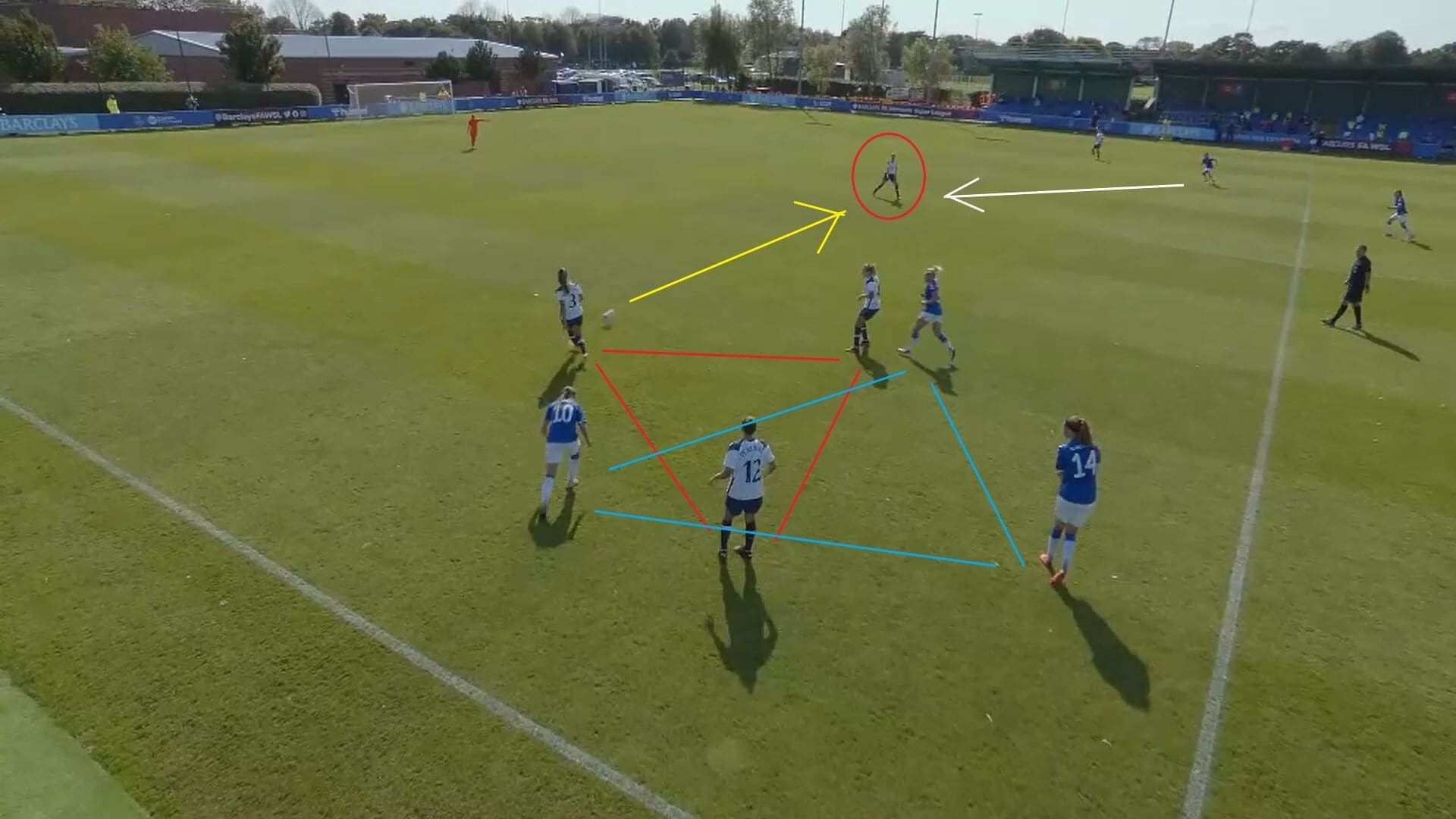
Here, it is a different setup. Everton are still attacking together, matching Tottenham’s structure, as we can see from the two triangles overlapping each other. This forces Tottenham to play the ball backwards, as the yellow arrow shows. However, once the ball reaches that fourth player, they are then instantly pressed by another Everton player, as the white arrow shows. This again means that Tottenham had no room to move the ball forward.
If we look back at the way Tottenham Hotspur Women played in attack, we remember how they only attacked with one player, their lone striker. Therefore, if we compare that to Everton’s team attack, we can see a big reason why Everton were able to win this game, and Tottenham weren’t.
If we now come back to the impact that Nicoline Sorensen had on the game when she came on, we can see how Everton’s change in attacking structure also allowed them to win the game.

We have seen already how Hayley Raso had the best opportunity for Everton in the first half, and was their most lively player. However, they were unable to find a breakthrough. This image shows us one reason for this. Captain Lucy Graham, wearing number 17 and in the blue circle, is looking to play the ball forwards into the space. However, there are no Everton players looking to offer a passing option there. With Tottenham moving to cut off the space behind, Everton needed someone to make a run earlier. Izzy Christiansen, in the yellow circle, did attempt a run, but it was too late to be effective.
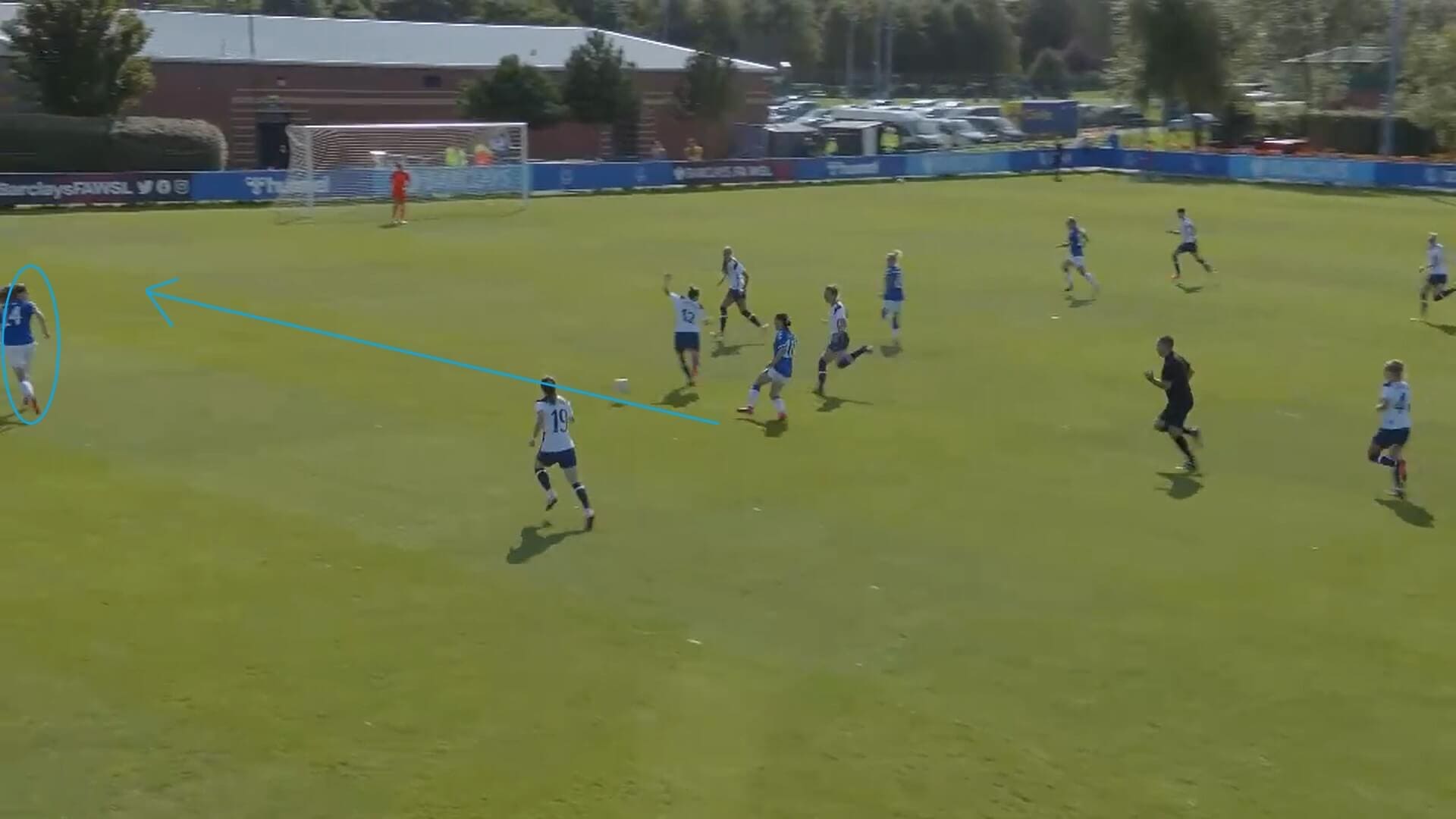
Therefore, it is clear what Everton needed in the second half to create a goalscoring chance. In this image, we can see how Sorensen was making these forward runs in the second half. What makes this point even more important is that this is when Everton’s goal was scored. The ball went forward to Sorensen, who played a cross into the area for Christiansen to head in. Therefore, we can make a direct comparison between their first and second half attacking, and show how the switch in their tactics and the introduction of Sorensen opened up more opportunities for them, with one leading directly to their goal.
This section has shown, in several ways, how Everton’s attack was better than Tottenham’s in the first half, but still struggled to create chances. However, because they attacked as a team, rather than as a single player like Tottenham did, they could adjust their tactics to create more opportunities. Bringing on Nicoline Sorensen meant that they could get behind the Tottenham defence in the second half, which they were unable to do in the first half, and it was this that led to the goal that won them the game. Their team pressing tactics also meant that they could continue to pressurise the Tottenham defence, even after making tactical changes, which meant that they could continue to control the game.
Izzy Christiansen
The final thing this analysis will look at is the role of Izzy Christiansen in Everton Women’s win, aside from scoring the only goal of the game.

Christiansen, who moved to Everton from Lyon in December last year, likes to play in a playmaker role, often controlling the midfield and allowing others to get into forward positions. This is evident in the images we will look at in this section.
The above example shows how Christiansen has received the ball, and is looking to move it forwards to a teammate. You can see how there is an Everton attacker looking to move forwards, as indicated by the blue arrow. In these situations, Christiansen plays almost one touch passes, meaning that she can switch the ball to wherever it needs to be quickly, keeping Everton on the front foot in attack. Even though the passing option indicated is not used, it puts a doubt in the minds of the Tottenham defenders. Therefore, this is one way that Christiansen can direct play from the midfield areas.
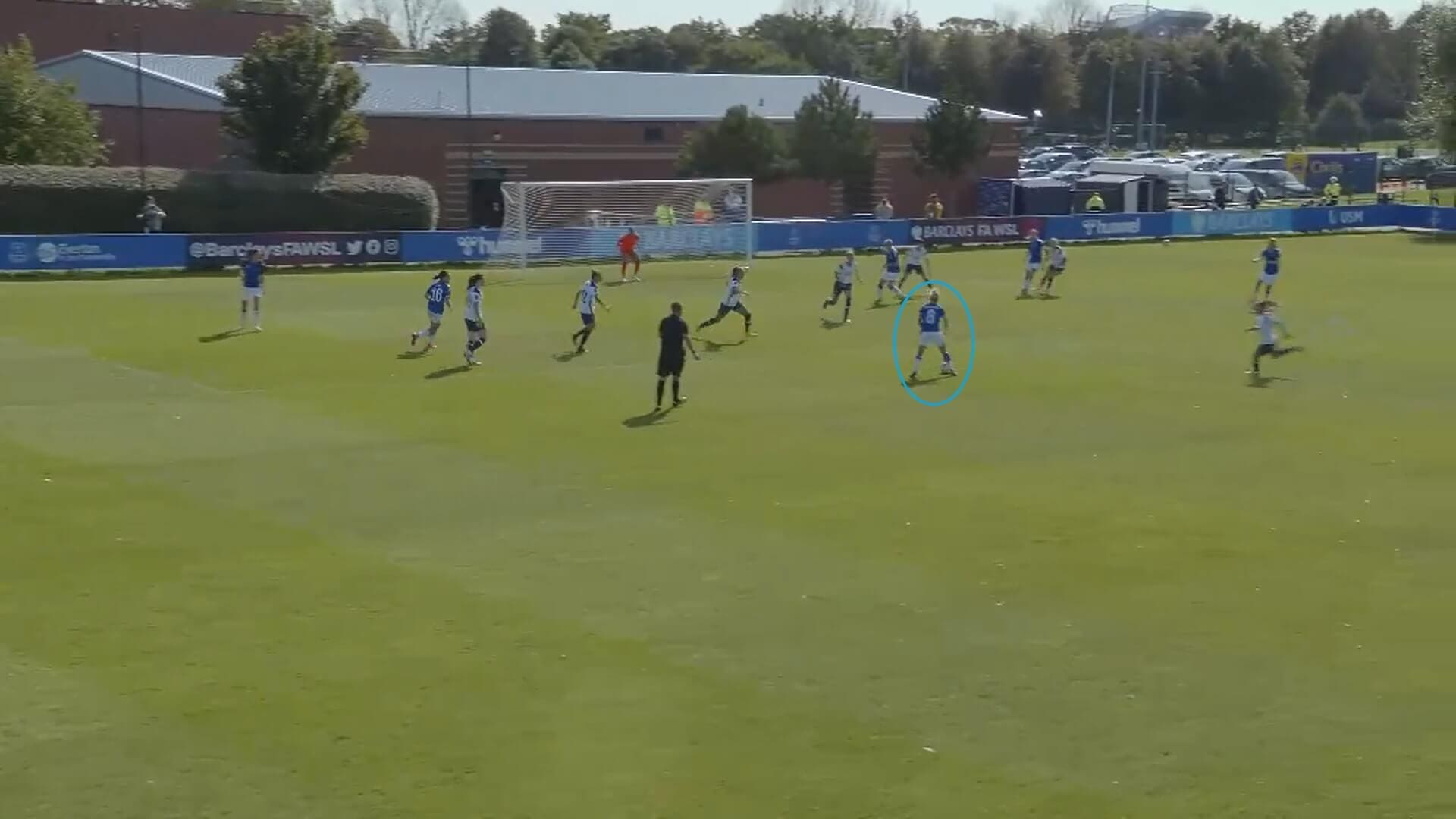
This is another example that shows how Christiansen takes up positions behind the main attack. Here, she is also in possession, and has plenty of options with the ball. The Everton attackers have spread around the box, so she can either pass to a teammate or shoot at goal from her current position. Like with the first example, she provides the link between each of the players, and ensures that the ball can go where Everton are best placed to use it.
We know she can also adapt her play from being a playmaker to a goalscorer when in the final third, as she scored the only goal in this game. Therefore, she is an important player in the team, and gives them lots of options tactically. When games like this come along, and chances are at a premium, she can be the one to make the right pass or score a goal, helping Everton to win tight matches.
It is important for teams to have this type of player in their squad, for the reasons we have already looked at. There is no doubting that, as Everton attempt to break into the top four this season, bringing in Christiansen last December was a good move in helping them reach the next level.
Conclusion
In conclusion, this was not a game that will go down as a classic in WSL history, with chances few and far between, but the difference that gave Everton Women the win was the way that they set up in attack, compared to Tottenham Hotspur Women, as we have explored in different ways in this analysis. Tottenham have yet to win in their first two games this season, with the North London derby coming up next for them in the WSL. Everton, who have now won two from two, will hope that this early season form continues when they travel to promoted Aston Villa Women in their next WSL game.





Comments